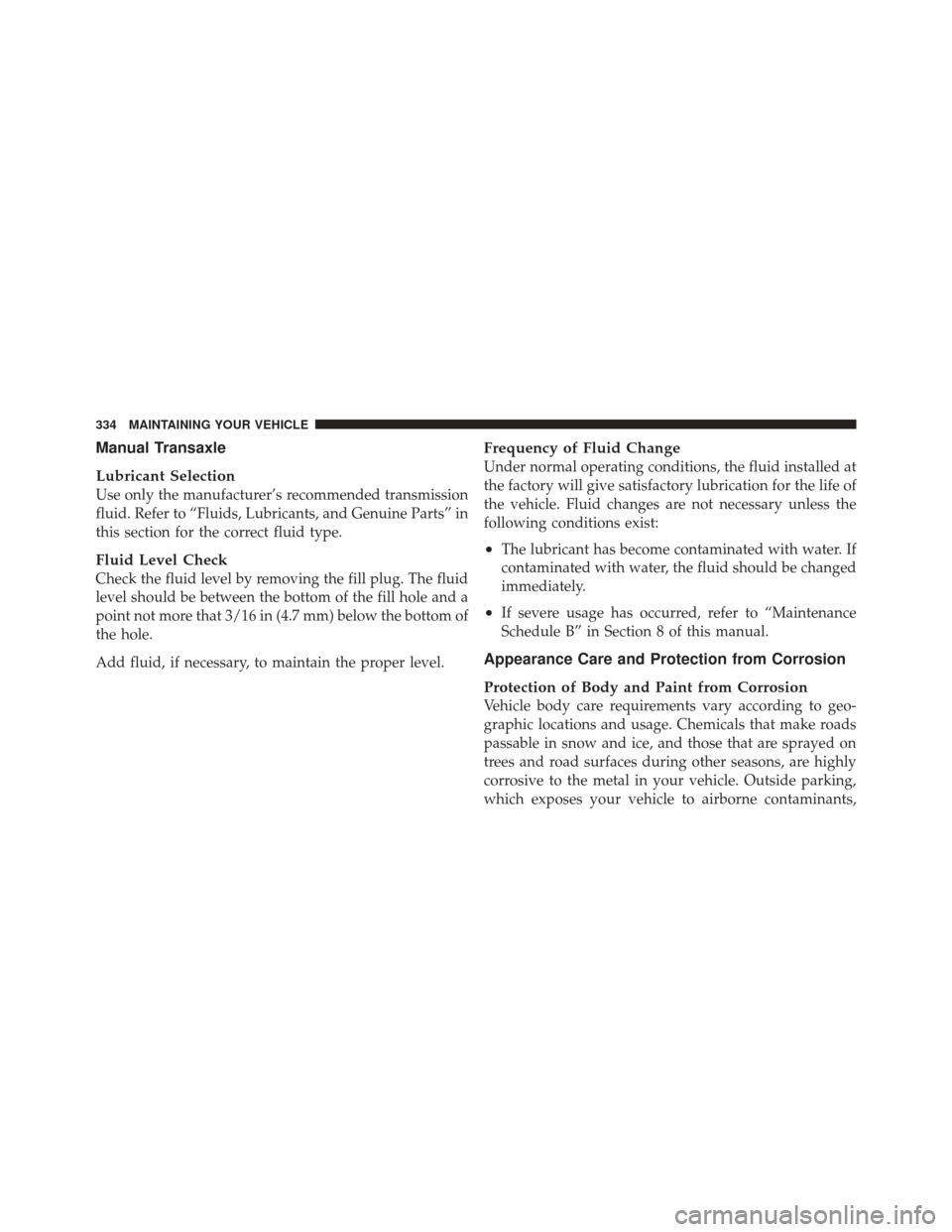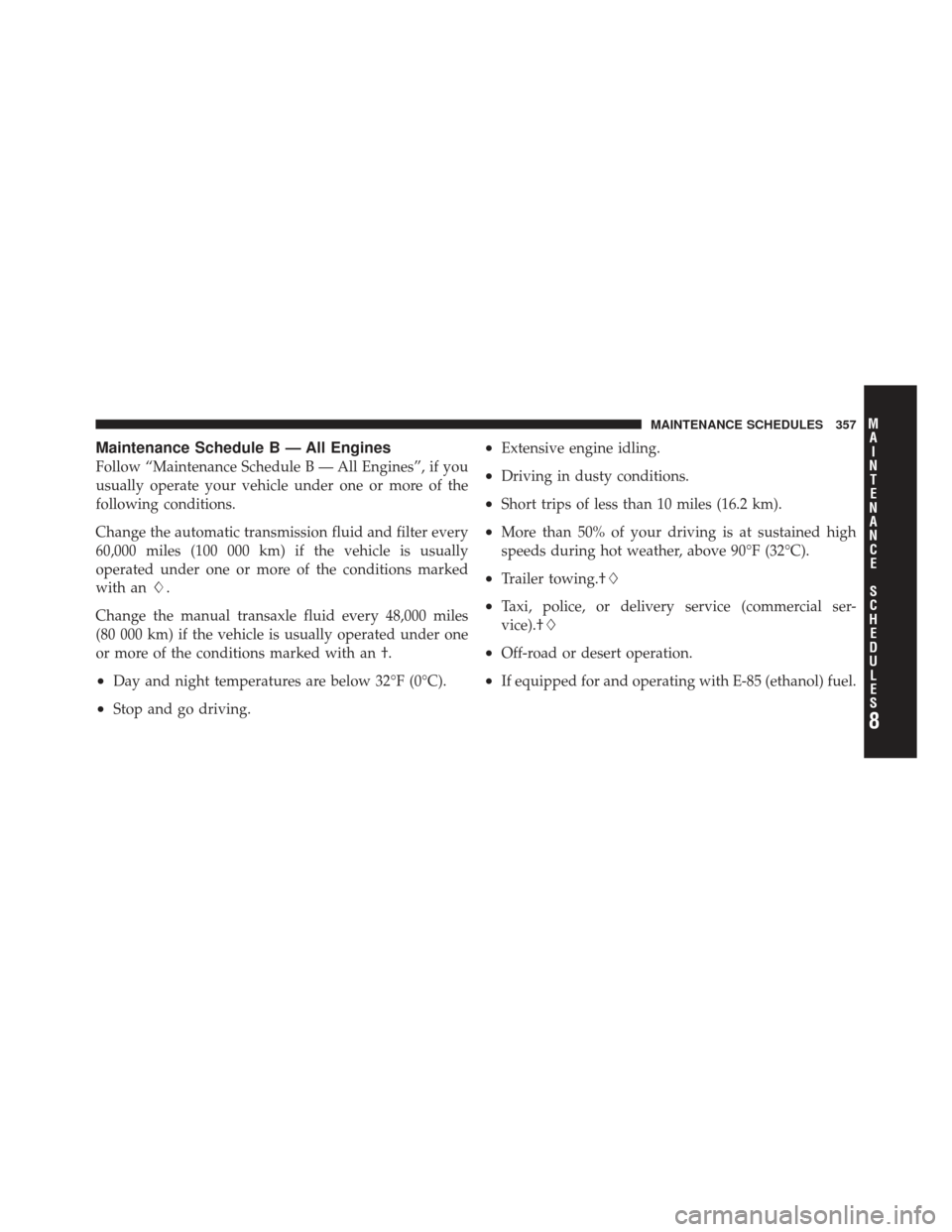Page 223 of 410
STARTING AND OPERATING
CONTENTS
�Starting Procedures .................... 224
▫ Manual Transaxle — If Equipped ......... 224
▫ Automatic Transaxle — If Equipped ....... 224
▫ Normal Starting ..................... 224
▫ Extreme Cold Weather
(Below �20°F Or �29°C)............... 225
▫ If The Engine Fails To Start ............. 225
▫ After Starting ....................... 226
▫ Turbocharger �Cool-Down� ............. 226 �
Manual Transaxle — If Equipped .......... 226
▫ Five–Speed Manual Transaxle ........... 226
� Automatic Transaxle — If Equipped ........ 229
▫ Brake/Transmission Interlock System ...... 230
▫ Four-Speed Automatic Transaxle ......... 231
▫ Gear Ranges ........................ 232
� AutoStick� — If Equipped ............... 234
▫ Operation ......................... 235
▫ General Information .................. 235
5
Page 284 of 410

Trailer Towing Weights (Maximum Trailer Weight Ratings
The following chart provides the maximum trailer weight ratings towable for your given drivetrain.
Trailer Towing Weights
Engine/Transmission Frontal Area Max. GTW
(Gross Trailer Wt.) Max. Tongue Wt.
1
2.4L NA and 2.4L Turbo/Automatic* 20 sq ft (1.9 sq m) 1,000 lbs (454 kg) 110 lbs (50 kg)
2.4L NA and 2.4L Turbo/Manual* 20 sq ft (1.9 sq m) 1,000 lbs (454 kg) 110 lbs (50 kg)
* NA (Naturally Aspirated)
1The trailer tongue weight must be considered as part of the combined weight of occupants and cargo, and
should never exceed the weight referenced on the Tire and Loading Information placard. Refer to the following
“Tire–Safety Information” section in this manual.
Refer to local laws for maximum trailer towing speeds.
Trailer and Tongue Weight
Always load a trailer with 60% to 65% of the weight in
the front of the trailer. This places 10% to 15% of the
Gross Trailer Weight (GTW) on the tow hitch of your
vehicle. Loads balanced over the wheels or heavier in the
rear can cause the trailer to sway severelyside to side, which will cause loss of control of the vehicle and trailer.
Failure to load trailers heavier in front is the cause of
many trailer accidents.
Never exceed the maximum trailer tongue weight
stamped on your bumper or trailer hitch.
282 STARTING AND OPERATING
Page 286 of 410

CAUTION! (Continued)
•During the first 500 miles (805 km) of trailer
towing, limit your speed to 50 mph (80 km/h).
Perform the maintenance listed in Section 8 of this
manual. When towing a trailer, never exceed the GAWR,
or GCWR ratings.
WARNING!
•Improper towing can lead to an injury accident.
•Make certain that the load is secured in the trailer
and will not shift during travel. When trailering
cargo that is not fully secured, dynamic load shifts
can occur that may be difficult for the driver to
control. You could lose control of your vehicle and
have an accident.
•When hauling cargo or towing a trailer, do not over-
load your vehicle or trailer. Overloading can cause a
loss of control, poor performance or damage to brakes,
axle, engine, transmission, steering, suspension, chas-
sis structure or tires.
•Safety chains must always be used between your
vehicle and trailer. Always connect the chains to the
frame or hook retainers of the vehicle hitch. Cross the
chains under the trailer tongue and allow enough
slack for turning corners.
•Vehicles with trailers should not be parked on a grade.
When parking, apply the parking brake on the tow
vehicle. Put the tow vehicle automatic transmission in
PARK. Always, block or �chock�the trailer wheels.
•GCWR must not be exceeded.
284 STARTING AND OPERATING
Page 292 of 410
Cooling System
To reduce potential for engine and transmission over-
heating, take the following actions:
•City Driving
When stopped for short periods of time, put transmission
in NEUTRAL but do not increase engine idle speed.
•Highway Driving
Reduce speed.
•Air Conditioning
Turn off temporarily.
RECREATIONAL TOWING (BEHIND
MOTORHOME, ETC.)
Towing — Manual Transaxle
If your vehicle is equipped with a manual transaxle, it
may be towed with all four wheels on the ground, in a
forward direction, at any legal highway speed, for any
distance, if the transaxle is in NEUTRAL.
Towing — Automatic Transaxle
CAUTION!
Recreational towing on vehicle’s equipped with a
automatic transaxle is not recommended.
NOTE: If the vehicle requires towing, make sure all four
wheels are off the ground.
290 STARTING AND OPERATING
Page 299 of 410
WARNING! (Continued)
•Always park on a firm, level surface as far from
the edge of the roadway as possible before raising
the vehicle.
•Block the wheel diagonally opposite the wheel to
be raised.
•Set the parking brake firmly, and shift a automatic
transmission into PARK; a manual transmission
into REVERSE.
•Never start or run the engine with the vehicle on a
jack.
•Do not let anyone sit in the vehicle when it is on a
jack.
•Do not get under the vehicle when it is on a jack.
•Only use the jack in the positions indicated and
for lifting this vehicle during a tire change.(Continued)
WARNING! (Continued)
•If working on or near a roadway, be extremely
careful of motor traffic.
•To assure that spare tires, flat or inflated, are
securely stowed, spares must be stowed with the
valve stem facing the ground.
•Turn on the Hazard Warning flasher.
1. Remove the scissors jack and lug wrench from the
stowage bag.
Jack Warning Label
6
WHAT TO DO IN EMERGENCIES 297
Page 336 of 410

Manual Transaxle
Lubricant Selection
Use only the manufacturer’s recommended transmission
fluid. Refer to “Fluids, Lubricants, and Genuine Parts” in
this section for the correct fluid type.
Fluid Level Check
Check the fluid level by removing the fill plug. The fluid
level should be between the bottom of the fill hole and a
point not more that 3/16 in (4.7 mm) below the bottom of
the hole.
Add fluid, if necessary, to maintain the proper level.
Frequency of Fluid Change
Under normal operating conditions, the fluid installed at
the factory will give satisfactory lubrication for the life of
the vehicle. Fluid changes are not necessary unless the
following conditions exist:
•The lubricant has become contaminated with water. If
contaminated with water, the fluid should be changed
immediately.
•If severe usage has occurred, refer to “Maintenance
Schedule B” in Section 8 of this manual.
Appearance Care and Protection from Corrosion
Protection of Body and Paint from Corrosion
Vehicle body care requirements vary according to geo-
graphic locations and usage. Chemicals that make roads
passable in snow and ice, and those that are sprayed on
trees and road surfaces during other seasons, are highly
corrosive to the metal in your vehicle. Outside parking,
which exposes your vehicle to airborne contaminants,
334 MAINTAINING YOUR VEHICLE
Page 353 of 410
Chassis
ComponentFluid, Lubricant, or Genuine Part
Automatic Transmission MOPAR�ATF+4 Automatic Transmission Fluid
Manual Transmission MOPAR�ATF+4 Automatic Transmission Fluid
Brake Master Cylinder/Manual
Transmission Clutch System MOPAR�
DOT 3 Brake Fluid, SAE J1703 should be used. If DOT 3, SAE
J1703 brake fluid is not available, then DOT 4 is acceptable. Use only rec-
ommended brake fluids.
Power Steering Reservoir MOPAR�Power Steering Fluid +4, MOPAR� ATF+4 Automatic Transmis-
sion Fluid
7
MAINTAINING YOUR VEHICLE 351
Page 359 of 410

Maintenance Schedule B — All Engines
Follow “Maintenance Schedule B — All Engines”, if you
usually operate your vehicle under one or more of the
following conditions.
Change the automatic transmission fluid and filter every
60,000 miles (100 000 km) if the vehicle is usually
operated under one or more of the conditions marked
with an .
Change the manual transaxle fluid every 48,000 miles
(80 000 km) if the vehicle is usually operated under one
or more of the conditions marked with an †.
•Day and night temperatures are below 32°F (0°C).
•Stop and go driving.
•Extensive engine idling.
•Driving in dusty conditions.
•Short trips of less than 10 miles (16.2 km).
•More than 50% of your driving is at sustained high
speeds during hot weather, above 90°F (32°C).
•Trailer towing.†
•Taxi, police, or delivery service (commercial ser-
vice).†
•Off-road or desert operation.
•If equipped for and operating with E-85 (ethanol) fuel.
8
M A I
N T
E
N A
N CE
S
C
H E
D
U L
E
SMAINTENANCE SCHEDULES 357